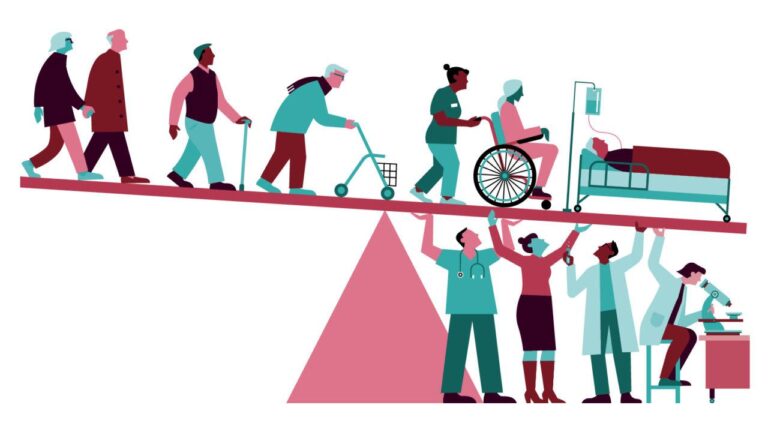As the global population ages at an unprecedented rate, the demand for effective, accessible, and personalized healthcare is more urgent than ever before. Enter HealthTech—a dynamic fusion of technology and healthcare—that is revolutionizing the way we address the complex needs of older adults. From remote monitoring and telemedicine to AI-driven diagnostics and personalized care plans,HealthTech innovations are not only enhancing the quality of life for aging individuals but also easing the burden on caregivers and healthcare systems alike. In this article, we explore how HealthTech is transforming care for aging populations, offering promising solutions that ensure dignity, independence, and improved health outcomes in the golden years.
Table of Contents
- The Rise of Remote Monitoring Technologies Enhancing Elderly Care
- Integrating Artificial Intelligence for Personalized Health Management
- Addressing Accessibility and Training Challenges in HealthTech Adoption
- Best Practices for Implementing HealthTech Solutions in Senior Care Settings
- Wrapping Up
The Rise of Remote Monitoring Technologies Enhancing Elderly Care
Advances in remote monitoring technologies have revolutionized the landscape of elderly care, allowing caregivers to deliver personalized, real-time health insights without the need for constant physical presence. Wearable devices and smart sensors collect crucial data such as heart rate,blood pressure,activity levels,and even sleep patterns,enabling early detection of potential health issues.This seamless connectivity empowers healthcare professionals to intervene promptly, reducing hospital admissions and enhancing the overall quality of life for seniors.
Along with health metrics, these technologies foster greater independence among older adults by providing safety features like fall detection, medication reminders, and emergency alerts. Families and caregivers benefit from dashboards and mobile apps that offer detailed reports and actionable notifications, fostering peace of mind without intrusive supervision. Key benefits include:
- Proactive health management through continuous monitoring
- Improved safety and emergency responsiveness
- Enhanced communication between seniors, families, and healthcare providers
- Cost-effective care by minimizing unneeded clinical visits
As these innovations continue to evolve, thay promise a more connected and compassionate approach to eldercare, blending technology with human oversight.
Integrating Artificial Intelligence for Personalized Health Management
Artificial Intelligence (AI) is revolutionizing the way healthcare providers approach individualized care for older adults. By analyzing vast amounts of data—from electronic health records to wearable devices—AI algorithms can detect subtle patterns that human providers might overlook. This capability enables the creation of highly tailored health plans that adapt in real-time to an individual’s changing condition, lifestyle, and preferences. Moreover, AI-driven predictive analytics help anticipate potential health risks before symptoms arise, facilitating preventive interventions that improve quality of life and reduce hospitalizations.
Key advantages of integrating AI into personalized health management include:
- Continuous monitoring: Wearables and iot devices provide 24/7 data streams, enabling ongoing assessment without intrusive clinical visits.
- Enhanced decision support: Advanced algorithms assist clinicians in selecting optimal treatment plans based on an individual’s unique profile.
- Improved medication management: AI tools can detect interactions and adherence patterns, ensuring safer pharmaceutical use.
- Empowered patients: Interactive AI interfaces encourage seniors to take an active role in managing their health.
As these technologies evolve, they promise to transform aging care into an era of precision health that respects autonomy while leveraging innovation for better outcomes.
Addressing Accessibility and Training Challenges in HealthTech Adoption
While the promise of HealthTech is immense, its prosperous implementation hinges on overcoming notable barriers related to accessibility and training. Many aging individuals face physical, cognitive, or sensory limitations that can make interacting with new technology daunting. Additionally,socio-economic disparities often limit access to necessary devices or reliable internet connections. To bridge this gap, inclusive design principles must be prioritized, ensuring interfaces are intuitive and adaptive. Moreover, community-driven programs that facilitate affordable access to devices and connectivity are vital in creating an equitable HealthTech landscape.
Equipping healthcare professionals and caregivers with the right knowledge to utilize new technologies is equally crucial. Complete training initiatives—focused not only on technical proficiency but also on empathetic use—help foster confidence and maximize the benefits of HealthTech solutions. Successful strategies often include:
- Hands-on workshops tailored to practical, scenario-based learning
- Continuous education modules that evolve alongside technology updates
- Peer support networks encouraging ongoing collaboration and troubleshooting
Such multi-faceted approaches ensure that both caregivers and older adults can navigate digital healthcare tools effectively, enabling seamless integration of HealthTech into everyday care routines.
Best Practices for Implementing HealthTech Solutions in Senior Care Settings
Successfully integrating HealthTech in senior care requires more than just deploying the latest devices. Organizations must prioritize personalization and ease of use, ensuring that technologies cater to the unique needs and capabilities of older adults. Engaging caregivers and the seniors themselves early in the decision-making process fosters acceptance and enhances the utility of these tools. Furthermore, safeguarding privacy through robust data protection protocols is indispensable, as seniors are among the most vulnerable populations when it comes to sensitive health data.
Effective implementation is also anchored in ongoing training and support. Healthcare staff and family members should be equipped with clear guidance and responsive troubleshooting resources to maximize technology benefits. Emphasizing interoperability between systems ensures seamless data flow across care teams,facilitating better clinical decisions and continuity of care. Key considerations include:
- Regularly updating software to enhance security and functionality
- Incorporating user feedback to refine digital interfaces
- Choosing scalable solutions that adapt to changing care environments
- Promoting collaborative partnerships between tech developers and senior care providers
Wrapping up
the rapid advancements in HealthTech are profoundly reshaping the landscape of care for aging populations. Through innovations such as remote monitoring, telehealth, and AI-driven diagnostics, we are witnessing a shift towards more personalized, efficient, and accessible healthcare solutions. These technologies not only enhance the quality of life for older adults but also empower caregivers and healthcare providers to deliver timely and effective interventions.As HealthTech continues to evolve, it holds the promise of addressing the unique challenges faced by aging communities worldwide, ultimately fostering healthier, more independent lives for seniors. Staying informed and embracing these innovations will be crucial for policymakers,practitioners,and families alike as we navigate this transformative era in healthcare.

